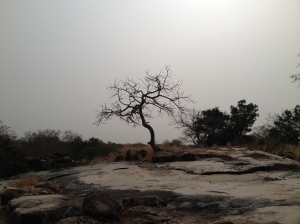
The Northern Region and Upper East are beautiful areas of Ghana. A rich variety of browns and greys met my eyes in this Savanna landscape during the beginning of the dry season. Traditional round mud houses with thatched roofs and also traditional rectangular mud houses with defensive fortifications are some of my favorite features that tell stories about this region. The round homes speak to me of an Afrocentric view of the world that is not all angular corners, but rather the circular forms of nature, the seasons returning again and again and the cycle of life. The defensive homes of the Upper East speak of resistance to slavery and the ancestral home of many African Americans whose ancestors came from this place.
I visited during the week of Dec. 19-21 to witness the Sandema Fiok Festival, which is a harvest festival that also celebrates resistance to slavery. It turns out that the actual festival was postponed a few days but my friends and I got to see the dress rehearsal which was quite amazing. I also enjoyed the quiet times and after the festival and my visit to the market.
In the Northern Region capitol, Tamale, and in Yendi, Bolgatanga, and Sandema, I noticed many more motorbikes and bicycles than cars and in the smaller cities and villages, donkeys were equally prominent.
I saw yams are growing in fields with many mounds, and flat expanses of cereals such as rice and millet. The Northern region is the largest of the ten regions in the country, but is home to only about 10% of the population of Ghana. The landscape of the Northern Region and Upper East is savanna, that is grasses and scrub with scattered trees. Wild or “bush” animals are hunted It is dry but various branches of the Volta extend into it and there is dry season gardening near the river. December, when I was there, is the dry season, with temperatures reaching 100 degrees. It can be 68 degrees at night and into the morning and the continuous wind makes it feel cooler. I was also under the pleasant illusion that the sky was cloudy due to the haze of the dust and this made it more pleasant for me since I get headaches in bright sunlight.

I will include a few facts about the North drawn from other sources, as well as some links. “The major ethnic groups of the region are the Mole Dagbon, (52.2%) the Gurma, (21.8%) the Akan and the Guan (8.7%). Among the Mole-Dagbon, the largest subgroup are the Dagomba and the Mamprusi, while the Komkomba are the largest of the Gurma, the Chokosi of the Akan and the Gonja of the Guan. The Dagomba constitute about a third of the population of the region.” (ghanadistricts.com) I have seen varying statistics on religion, but it seems that just over half of the population of the North professes Islam, while Indigenous religion and Christianity form about 20 percent each. I heard the Muslim call to prayer regularly in the cities and towns and saw many small mosques in villages, but I also saw many Christian churches and some indigenous shrines.
These photos show a mosque at Wulugu and the Catholic Cathedral of Our Lady of Seven Sorrows at Navrongo, exterior and interior, which has frescoes created by the women potters of Sirigu, also in the Upper East.
My visits to the Slave Camp at Pikworo and the Saakpuli Slave Market and village were stark and moving. There are no castles or large forts here as there were at the coast of Ghana. There were simply Baobabs and other trees were enslaved people were tied and rocks where they were said to have eaten their meals. In each place, there were wells, either dug by the enslaved or occurring in the rocks. A guide led me and others through both of the sites. I imagined the fear and pain of being brought to one of those places as a captive, but today there is almost reverential and haunting quiet. Simple rock circles are placed in the area of the cemetery at Pikworo.


Saakpuli is an isolated village, said to have been founded by the Asante in the 1700s as a military and trading post. There is an ancient Baobab tree that is the symbol of the site and has been alive long enough to have been part of slavery times. I met some small children in Saakpuli who reminded me of Hannah, who did not travel with me, but whom I was missing. A child held my hand throughout the tour. I was reminded strongly of Hannah’s enslaved ancestors who may have begun their journey to America in this place.
My next experience was a cathartic and exuberant demonstration of resistance to slavery. It was the Fiok Festival, which is a harvest festival that also celebrates the warrior tradition of resistance by the Bulsa people. We attended the dress rehearsal in Sandema and watched parades of elders and young men in traditional dress from the surrounding villages. I’m posting a lot of photos because their clothing and hunting trophies were awe-inspiring. You can tell this is a region with cattle and antelope and the horns on the helmets could even be a disguise at a distance if a group raised a great deal of dust (which is not hard to do in this landscape!). Note the quivers of arrows and the display of bows in the stylized dances. There were drummers and other musicians as well as cheering, dancing women as the warriors went from the chief’s palace grounds through the town. Yes, I joined in as a participant-observer!
I felt privileged to witness this festival dress rehearsal, at which we seemed to one of only two small groups of visitors from outside Ghana. I was inspired by the spirit of the people of these northern regions of Ghana!



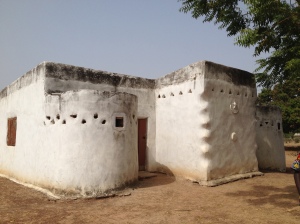


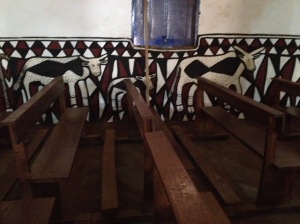






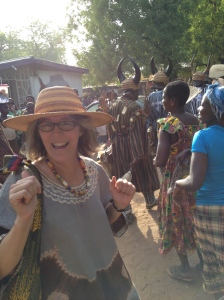


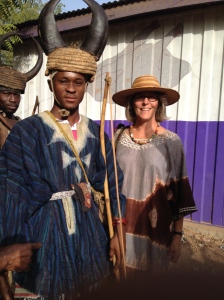


I’m so enjoying your blog. You are having fabulous experiences and the photos are beautiful. Your time in Africa will enrich the experience of all our students.
Thank you for reading and viewing the photos.